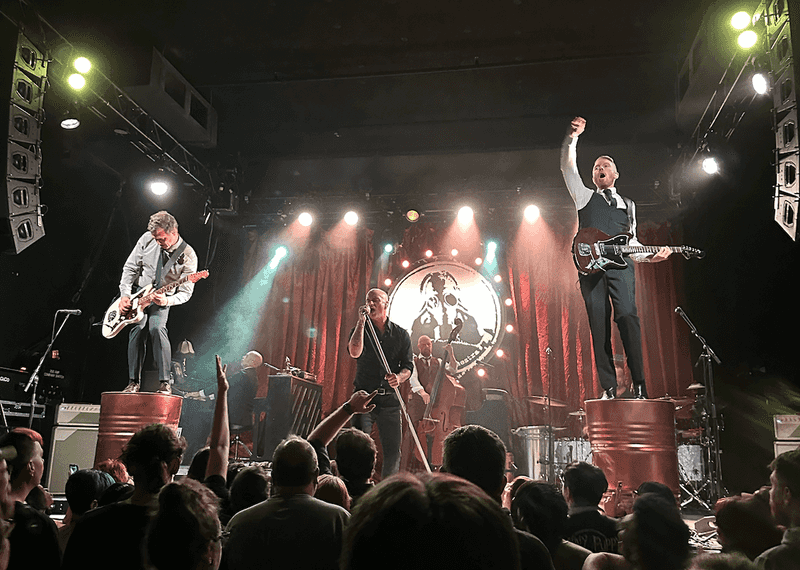“It’s Music!”: Kaizers Orchestra Keeps Punk Alive

// Photo courtesy of Annabel Ma
The first band member was wearing a gas mask. He walked stiffly, examining the audience as if we were a mass of alien life forms. Eventually, he made it to his little corner of the stage, a room composed of a swivel chair between a piano and a pump organ. He sat silently in his mess of decor—a vintage portrait, an army helmet filled with roses, a lamp, a vintage metal telephone, a small bottle of vodka—and began to play the organ.
His name is Helge Risa, one sixth of the Norwegian-born fusion rock band Kaizers Orchestra. Following him onstage was the erratic Geir Zahl, who donned a gray blue suit and an endearing tendency to shuffle around uncontrollably when the sound of his own music moved him. Lead singer Jannove Ottesen walked in with a massive smile, the reciprocal of Helge Risa (who, at this point, was completely immersed in his pump organ). Rune Solheim, the drummer, walked straight to his post in the back and got to work, while Øyvind Storesund, whom I can only describe as Flea on a double-bass, elegantly took off his speakeasy fedora and placed it on a nearby amp. Finally, Terje Winterstø Røthing, the other guitarist, entered, his unsettled gaze raking the audience. The band began to play.
Perhaps the most appealing aspect of Kaizers Orchestra is unapologetic genre-bending. Their attire is vintage, yet steampunk, but also doomsday, but maybe more militarist? Their music is no less extensive, spanning Eastern-European folk rock, funk, gospel, alternative rock, rap, and traditional ballad. Perhaps it is this indefinable quality that makes them an orchestra: they play whatever their instruments allow them to play, and they play it well. “We are here to make a lot of noise and try to organize it into an interesting form,” Jannove Ottesen explained to the audience. Then, he proceeded to repeatedly slam a metal pipe against a massive copper barrel. This had happened a few times already at this point. It was enthralling nonetheless.
That brings me to the topic of unapologetic outlandishness. Whether it was the way that Helge Risa moved his eyes to look at the audience yet kept his head in place, or the extended period of unbroken eye contact that Terje Winterstø Røthing made with a spot on the wall during a guitar solo, there was something admirable about the band’s ability to completely let go of control for an hour and a half. Each of them seemed to have an uncontrollable reaction to the music, as well, with some waving hands as if playing an invisible theremin. “They say there is a language barrier, but no!” said Ottesen. “It’s music!”
The audience seemed to catch the infectious music bug as well. It was hard not to—Ottesen’s presence was almost authoritarian. He conducted the audience with his hands, cried out “hallelujah!”, and somehow got the audience clapping along to complex idiosyncratic beats. The audience, a mass of paddy caps, handlebar mustaches, and dyed hair, shook their heads and shook their hands in ecstasy. A man in the front nearly fell to his knees. A woman stood with hands clasped and tears running down her face for nearly the whole show. A large mass of Norweigans sang along to every song. Nearby, a large mass of Americans who seemed to have learned the language through Kaizers Orchestra's lyrics joined in. The Eastern-European folk rock songs in particular seemed to drive everyone nuts (myself included). It brought me back to Banaimitsvah season in 7th grade; Namely, the rabid joy the sound of Hava Nagila would unleash upon my classmates. Kaizers orchestra took that sound, added hardcore guitar and powerful metal-on-metal percussion, and created something special.
Whether or not you love rock, Kaizers Orchestra promises a once-in-a-lifetime show, complete with pipes flying through the air, an entire bottle of vodka being downed in small increments, pulsing lights, incessant crowd work, and, most importantly, heart. Their show was an important reminder that hardcore is all about dissonance, and the greatest dissonance of all is that often the most hardcore performers are the kindest, most enthusiastic, most earnest people out there. Their commitment to innovation, personality, and their Norwegian roots proved to be the light of my week. I can’t imagine having spent a Wednesday night any other way. Stay weird, Kaizers Orchestra.